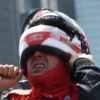
Why are they all banging into the limiter?
#1

Posted 17 April 2012 - 18:03
Advertisement
#2

Posted 17 April 2012 - 18:04
#3

Posted 17 April 2012 - 18:08
But in Shanghai, perhaps there was a change in wind direction from Fri/Sat to Sun? That would explain a few things.
#4

Posted 17 April 2012 - 18:09
#5

Posted 17 April 2012 - 18:12
#6

Posted 17 April 2012 - 18:25
But in Shanghai, perhaps there was a change in wind direction from Fri/Sat to Sun? That would explain a few things.
There was. IIRC Force India were caught out by it and struggled to overtake all day.
#7

Posted 17 April 2012 - 18:31
Yeah, they have to set the cars up for the optimum.
But in Shanghai, perhaps there was a change in wind direction from Fri/Sat to Sun? That would explain a few things.
in post race interviews some of the drivers mentioned a change in wind direction
#8

Posted 17 April 2012 - 18:31
There is no chance that any car will hit the rev limiter in 7th gear without a tow or DRS.
I dunno man, watch the race again, they seem to hit it early. Even the slow cars like RBR.
#9

Posted 17 April 2012 - 18:36
9.6.2 The maximum number of numerical change gear ratio pairs a competitor has available to him
during a Championship season is 30. All such gear ratio pairs must be declared to the FIA
technical delegate at or before the first Event of the Championship.
Not entirely sure what that means apart it may mean less than optimal ratios a few times?
Edited by Slowinfastout, 17 April 2012 - 18:38.
#10

Posted 17 April 2012 - 18:39
I dunno man, watch the race again, they seem to hit it early. Even the slow cars like RBR.
That's because RBR don't know how to setup a racing car that isn't on pole
#11

Posted 17 April 2012 - 18:50
#12

Posted 17 April 2012 - 19:06
#13

Posted 17 April 2012 - 19:06
From the tech regs:
Not entirely sure what that means apart it may mean less than optimal ratios a few times?
Sounds like it. But 30 is still a lot of choices. And some circuits are pretty close in terms of gearing. I'd not expect much of a difference between the dry setups at Sepang and Shanghai.
But like what Ross said, it's about the overtaking. Ideally, you want to be neck and neck with a driver going into the braking zone to make the pass. To do so, you need to catch the opponent as quick as possible.
I never understood why F1 drivers and race drivers in general do not short shift more though. At least in FF1600 cars, you get better acceleration.
#14

Posted 17 April 2012 - 19:15
these engines did what, 21 or 20,000 max revs a few years ago
so 18000 is already away from peak :/
#15

Posted 17 April 2012 - 19:18
Sounds like it. But 30 is still a lot of choices. And some circuits are pretty close in terms of gearing. I'd not expect much of a difference between the dry setups at Sepang and Shanghai.
But like what Ross said, it's about the overtaking. Ideally, you want to be neck and neck with a driver going into the braking zone to make the pass. To do so, you need to catch the opponent as quick as possible.
I never understood why F1 drivers and race drivers in general do not short shift more though. At least in FF1600 cars, you get better acceleration.
I don't understand what the wording of the regulations means when it says 'gear ratio pairs'... that's why I'm unsure what's the real impact of this rule.
Basically my understanding is they are entering the weekend with whatever ratios the simulations says they need, and obviously there is the parc fermé so any change would need to be made on Friday.. but if you combine that with the rule above it must basically mean they might have a set of gears for a bundle of tracks and it might be iffy a few times.
About short shifting, I guess it depends how peaky an engine is... the F1 engines are quite peaky so the power lies at the very top of the revs (which are already artificially limited quite far away from what they could do), so the best thing is to wound the hell out of them.
For instance, and by opposition, the current turbo rally engines have an extremely flat power curve so they will pull like hell from just about any revs, they can short-shift them at will depending on anticipation and the flow of the road ahead..
Edited by Slowinfastout, 17 April 2012 - 19:22.
#16

Posted 17 April 2012 - 19:19
There is no chance that any car will hit the rev limiter in 7th gear without a tow or DRS.
Hamilton was bouncing off the limiter half way down the main straight at Monza last year. Part of the reason he had difficulty passing MS.
#17

Posted 17 April 2012 - 19:27
#18

Posted 17 April 2012 - 19:32
Start with more fuel so they set the 7th gear for a compromise. Come 1/2 way through the race and they hit the limiter pretty easilly.
Good point, it has to work both for race and qualy too. You want it short enough for when the car is a pig full of fuel, and still have the best top speed you think you'll need..
#19

Posted 17 April 2012 - 19:45
I don't understand what the wording of the regulations means when it says 'gear ratio pairs'... that's why I'm unsure what's the real impact of this rule.
Basically my understanding is they are entering the weekend with whatever ratios the simulations says they need, and obviously there is the parc fermé so any change would need to be made on Friday.. but if you combine that with the rule above it must basically mean they might have a set of gears for a bundle of tracks and it might be iffy a few times.
About short shifting, I guess it depends how peaky an engine is... the F1 engines are quite peaky so the power lies at the very top of the revs (which are already artificially limited quite far away from what they could do), so the best thing is to wound the hell out of them.
For instance, and by opposition, the current turbo rally engines have an extremely flat power curve so they will pull like hell from just about any revs, they can short-shift them at will depending on anticipation and the flow of the road ahead..
I think the wording of the rules means you get a set amount of choices. Maybe a high gear and a low gear choice for that event? Even for a law student like myself, the wording of motorsports rule books are confusing and frustratingly impossible to understand.
Advertisement
#20

Posted 17 April 2012 - 19:50
Hamilton was bouncing off the limiter half way down the main straight at Monza last year. Part of the reason he had difficulty passing MS.
...Without DRSing / slipstreaming?
#21

Posted 17 April 2012 - 20:13
#22

Posted 17 April 2012 - 20:30
or just put another gear in and leave all the others the same.You only spend a little bit of time at the end of the longest straight on the rev limiter, so it's probably better to have the fractionally better mid-range acceleration. Especially if you're tying to pass someone. If you only catch them at the end of the straight you're already too close to the brake zone. You need to be closing on them and using the tow/DRS to get the momentum to blast by.
#23

Posted 17 April 2012 - 21:04
#24

Posted 17 April 2012 - 21:15
You also have to take into account performance with full tanks. I very much doubt any car was reaching top speed (without DRS) in the first half of the race.
#25

Posted 18 April 2012 - 00:07
Could this situation be partially alleviated if the FIA allowed the engines, in 7th gear only, to rev up to say, 22,000 rpm (their true performance). Maybe they could restrict it to race only, too. What with it being 7th gear only and only during the race, it shouldn't hurt the engines too much, would it?
I bet if they let engine development continue and never froze the RPM or had engine usage limitations we'd be seeing some crazy values by today. I wonder if they would have broke the 30,000 barrier!
#26

Posted 18 April 2012 - 00:44
I bet if they let engine development continue and never froze the RPM or had engine usage limitations we'd be seeing some crazy values by today. I wonder if they would have broke the 30,000 barrier!
At least 25k revs, and would be close to the old V10s in power I would guess.
Edited by Lennat, 18 April 2012 - 00:45.
#27

Posted 18 April 2012 - 00:47
#28

Posted 18 April 2012 - 02:04
as L H just got dinged for a trans swap
so how does individual gears work on a 5 race rule
are they allowed different final drive swaps in a 5 race window
or can they swap some gears only
or all new but of the 30 sets aloted
or 30 gears out of 7 needed so 4 complete sets ?
with a few top gears ?
what are the gear choices ?
or new guts each race a trans is just the case and shifters ?
#29

Posted 18 April 2012 - 02:35
same trans for 5 races
as L H just got dinged for a trans swap
so how does individual gears work on a 5 race rule
are they allowed different final drive swaps in a 5 race window
or can they swap some gears only
or all new but of the 30 sets aloted
or 30 gears out of 7 needed so 4 complete sets ?
with a few top gears ?
what are the gear choices ?
or new guts each race a trans is just the case and shifters ?
Each team must pre-select 30 ratio pairs for the entire season.
For each race weekend they select 7 ratios before FP1 and can make further changes once more before the end of FP2.
They have to declare the ratios they want to use on Saturday and Sunday by latest two hours after the end of FP2.
There are no 'sets', the team can use as many ratios of a particular dimension as they want throughout the season.
So yes, in terms of incurring a penalty it is really just going to be due to damage to the case, shifters and bearings.
#30

Posted 18 April 2012 - 02:45
It's one of the things I hate most in F1 at the moment, cars hitting the rev limiter half way down the straight. I first noticed it being a big problem in 2009 but maybe I just hadn't paid enough attention before. Could a rev un-limiter be added to or replace DRS? Or like the earlier poster said, unlimited 7th gear? Maybe it would have too much of a detrimental effect on reliability.
Add to that, a possibly solution perhaps would be that when DRS is enabled, then also the ECU would disengage the rev limiter, opening up the revs during this time.
Therefor less compromise in your gearing and hopefully better racing with one less technical bottleneck.
#31

Posted 18 April 2012 - 04:11
You only spend a little bit of time at the end of the longest straight on the rev limiter, so it's probably better to have the fractionally better mid-range acceleration. Especially if you're tying to pass someone. If you only catch them at the end of the straight you're already too close to the brake zone. You need to be closing on them and using the tow/DRS to get the momentum to blast by.
Well I thought in China they were quite close to limiter and thus top speed by the time DRS was enabled, thus more or less leaving it useless.
Edited by Oho, 18 April 2012 - 06:53.
#32

Posted 18 April 2012 - 07:40
#33

Posted 18 April 2012 - 08:29
Watching the onboards alomst all drivers hit the rev limiter, without DRS or what not, about 2/3rds of the way up the main straight. Add DRS and they were hitting it very early. One would think they would use longer gearing, especially to aid passing, but would longer gearing hurt the lap times if they went that way? There must be a good reason for it.
The perfect gearing for lap time in clean air is to just hit the limiter before the braking zone of the longest straight as you made full use of the peak power at the top of the rev range, in some cases (for laptime) it's fastest to hit the limiter slightly before as you spent more time at peak pwer even though you've stopped accelerating. It's obvious that Red Bull are still doing this even though though they aren't at the front which meant they used to be able to get away with it. If you're strategy relies on overtaking in the race it's really important to gear a slightly longer 7th that revs out in a slipstream with DRS and KERs but this will comprimise top speed in qualifying as you'll be revving lower in clear air = less power = less top speed in qual = potentially worse grid position. We saw how close they were in qual, a tenth may have been 3 grid slots.
All this said I would still lose that tenth in qualifying at every track (bar monaco maybe) to make sure could get past people easily in the race. I'm sure in hindsight Vettel would have also. The time he lost early in the race stuck behind people due to gearing probably cost him a podium in the end as he could have finished on better tyres by pitting later in stop 1 (he pitted early to avoid traffic cos couldnt pass).
#34

Posted 18 April 2012 - 13:16
#35

Posted 18 April 2012 - 13:20
the fia could mandate the 7th gear too, which is similer to what happens in nascar
Wouldn't that stop the type of race we saw in Monza 2010, with JB running a high downforce set up and Lewis running a low downforce setup up?
#36

Posted 18 April 2012 - 16:09
I think the wording of the rules means you get a set amount of choices. Maybe a high gear and a low gear choice for that event? Even for a law student like myself, the wording of motorsports rule books are confusing and frustratingly impossible to understand.
One "pair" consists of two gear wheels -> and this is one gear ratio.
#37

Posted 18 April 2012 - 22:26
I think the wording of the rules means you get a set amount of choices. Maybe a high gear and a low gear choice for that event? Even for a law student like myself, the wording of motorsports rule books are confusing and frustratingly impossible to understand.
I suggest you don't take up law then! 30 sets of ratios isn't hard to fathom, seeing as a ratio is by definition a pair of gears. You get 30 ratios, use them as you want, wherever they will fit in the gearbox.
Also, short shifting means shifting earlier then the optimum shift point. So no matter what the torque curve, short shifting will be slower, and is only beneficial when you're traction limited in helping improve control of wheelspin. But it just happens optimum shift for an F1 engine is on the limiter, cos thats where the power is!
Removing the rev limit for DRS is pretty ********, unless you want to guarantee engine failures! The engines have been developed to run to 18k for a number of years now, if a team doesn't want to gear to make use of DRS, then they should deal with it, and never bitch about how hard it is to overtake in F1!
If you're strategy relies on overtaking in the race it's really important to gear a slightly longer 7th that revs out in a slipstream with DRS and KERs but this will comprimise top speed in qualifying as you'll be revving lower in clear air = less power = less top speed in qual = potentially worse grid position.
Errrr, you got that wrong... a taller 7th helps you even more in qualifying!
#38

Posted 18 April 2012 - 23:22
The 6th gear would then have to be set to achieve the car's normal maximum speed, and the 7th gear would be purely for overtaking.
This would maybe work better with 8 speed gearboxes.
All of the teams are now following the path pioneered by Red Bull, and gearing for best race pace rather than for overtaking.
#39

Posted 18 April 2012 - 23:35
I suggest you don't take up law then! 30 sets of ratios isn't hard to fathom, seeing as a ratio is by definition a pair of gears. You get 30 ratios, use them as you want, wherever they will fit in the gearbox.
Also, short shifting means shifting earlier then the optimum shift point. So no matter what the torque curve, short shifting will be slower, and is only beneficial when you're traction limited in helping improve control of wheelspin. But it just happens optimum shift for an F1 engine is on the limiter, cos thats where the power is!
Removing the rev limit for DRS is pretty ********, unless you want to guarantee engine failures! The engines have been developed to run to 18k for a number of years now, if a team doesn't want to gear to make use of DRS, then they should deal with it, and never bitch about how hard it is to overtake in F1!
Alas, it really is that simple.
Edited by Dunder, 18 April 2012 - 23:36.
Advertisement
#40

Posted 19 April 2012 - 00:28
could well do, thats true :/Wouldn't that stop the type of race we saw in Monza 2010, with JB running a high downforce set up and Lewis running a low downforce setup up?
#41

Posted 19 April 2012 - 03:55
There is no chance that any car will hit the rev limiter in 7th gear without a tow or DRS.
You've been watching Formula 3 or what???
#42

Posted 19 April 2012 - 04:52
#43

Posted 19 April 2012 - 06:18
I liked the old days better when there were no rev limiters and there was a good likelihood a hand grenade would detonate in the back of the McLaren at some point during the race.
There were always rev limiters. But now it's fixed way below the engine's capabilities. That's why they are more reliable.
#44

Posted 19 April 2012 - 09:52

































